Sunday Nov 16, 2025
Sunday Nov 16, 2025
Saturday, 26 July 2025 00:00 - - {{hitsCtrl.values.hits}}
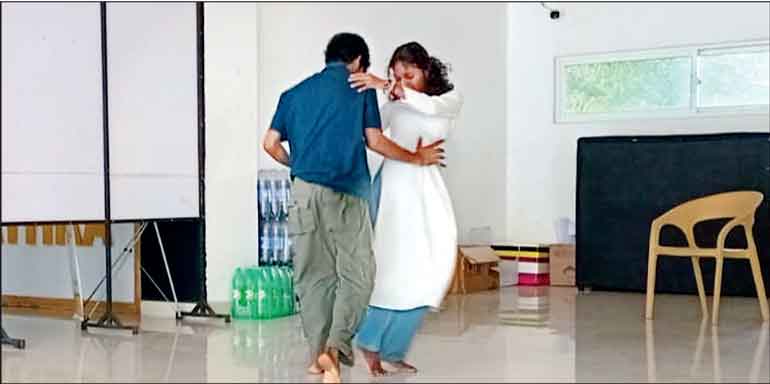
Practicing a dance that is a mixture of Eastern and Western cultures
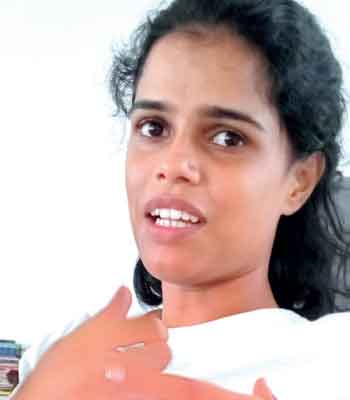 |
| Meerusha |
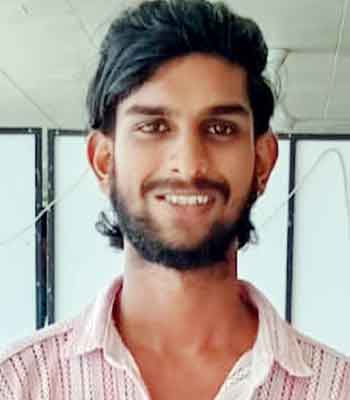 |
| Sumith |
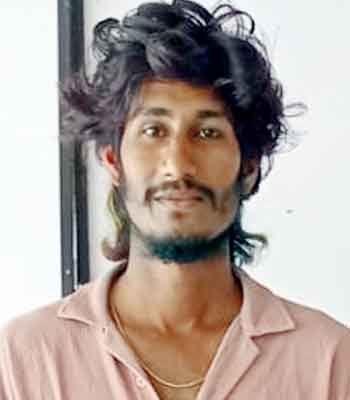 |
| Aravindan |
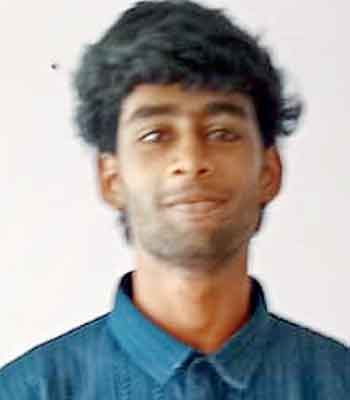 |
| Prakash |
By Surya Vishwa
Hailing from Point Pedro, Jaffna, Meerusha is 24 years old and it seems that she has danced before she could walk.
Living in the furthest location of the country did not stop her dreams.
At age 18 she meticulously planned the formation of her own dance teaching establishment and now boasts of a free style dance troupe by the name of SWAG. It comprises of her students, many of them older than her. They identify themselves as being a modernist free style dance group but also draws on traditional classical heritages.
What is unique is that all of them address Meerusha as ‘Master.’ In their eyes as well as hers, gender division does not exist and although petite in structure she embodies a personality that exudes pure dynamism and persona.
“I am energy. Pure energy. I am born in this lifetime as a female but I am formless as I dance. I merge into the universe,” she explains.
She has over 30 students from across Jaffna and conducts her classes at the Arc building belonging to Jekhan Arulliah who is on his own mission to support Northern artists.
We first met the SWAG dance group and Meerusha at the Open Mic performance that Jekhan has motivated a youth group to organise monthly.
The third edition of the Jaffna Open Mic was held last week at the garden space of the Arc building where many youth performed outstandingly in singing, rapping, spoken poetry and dance. Dance was the monopoly of Meerusha’s team who literally had the audience even the older ones, vibing to the beat.
“There are many dance groups in Jaffna and I am one of them,” she asserts, stating that her group has been selected as finalists for an international dance competition.
Isai Thullal dance competition
“The Isai Thullal dance competition is a famous international event held in Europe for the past 25 years and this year it includes Sri Lanka. My group has been selected for the finals and we will be performing at the grand finale scheduled for July 26th in Jaffna,” she explains.
Thus, the international Isai Thullal dance competition will be held today commencing 4 p.m. at the Ariyalai Community Center Ground featuring dance categories including classical, solo, duo and mixed genre group dances.
In the performance carried out by the SWAG group at the Open Mic event, what was seen were complex free style movements that included an Afro and Latin American quality, danced to high beat Tamil songs.
The next day morning the Harmony Page team was given a series of separate performances at the space at the Arc building that the SWAG group uses for their dance practices and classes.
The performances included story telling narrations through dance, created by Meerusha and also perennial Hinduistic dance rituals such as those connected with god Shiva.
The performances connected with gods are considered extremely sacred. The performers who do this kind of dance have a particular power in their eyes and in their body language even when not dancing.
This is the case of 26-year-old Aravind, a fervent Shiva devotee. Around 6 feet tall he dances as Shiva in the Tandeva known as the cosmic dance of Shiva which has many variations and stages representing the diverse nature of this powerful Hindu deity and his functions in the universe. Shiva is associated with the cyclic motions of existence representing destruction, transformation, creation and preservation and this is magnificently represented in dance.
“Always weak qualities in a human should be destroyed for the strong to dominate our psyche. There is a lot of philosophy that is enshrouded in Hinduistic dance rituals,” explains Meerusha who believes that every human holds a dominant universal energy.
“The entirety of the cosmos is in all of us. There is the sky, mountain, oceanic, deep earth, naga and various other energies connected to the universe and galaxies. We dancers generally feel all of it resonating within us when we dance. Sometimes I can connect a particular dominant universal energy within a student which influences their dance, but I do not tell then,” she notes.
Aghori dance
The Shiva connected Aghori dance performed for us, was carried out by Aravind and 21-year-old Sumith. This is the devotional dance performed usually by the Aghori ascetics in India to display their commitment to Shiva and the universal energy forces that conquer attachment and evil.
Looking at Aravind and his eyes it is possible for someone to guess that he holds a cosmic force within him but to see him dance is almost a supernatural experience.
The sweeping, precise movements and the emotion poured into the devotion of the story, as represented by Aravind and Sumith in the brief Aghori dance that we witnessed was enough to guess why this dance group in a once civil war stricken territory that is still lacking complete social support, made it to the finals of a prestigious dance competition such as the Isai Thulal global dance event.
“I have been training under Meerusha Master for the past four years and all I want to do is dance. No amount of family pressure for higher education or a career will make me change my mind. All of us have a commitment to dance whether we have enough money to eat or not,” laughs Aravind.
He sports slightly longish hair, the ends of which are coloured in green with a tinge of yellow.
I comment on it and he quips that he likes it very much, sounding the epitome of the artist who creates his own image and stage for life, as he wishes, carefree of what anyone thinks.
Sumith is the offspring of mixed Sinhala and Tamil parentage and has been living in Jaffna, within the city, since birth.
Soft spoken and largely silent his speech seems to be dance. But he does smile and state that like the rest of the SWAG group members and like his ‘Master’ Meerusha, he is wedded to dance.
“This is the only thing for me. Only dance.”
But he does want to marry and is searching for a girl, declares Meerusha.
We then briefly discuss the macro level issues connected with artistes in Sri Lanka and especially the North. Over the past seven years the Harmony page has consistently ideated on policy linked changes connected to the economy any government would have to take if they seriously mean their commitment to intangible cultural heritage which encompasses all arts. For example we have written that art and artists have to be included in national conferences that speak of economy and that banks should be educated to create savings products and create loan schemes for artistes in order to enable them to compete at local and international level. We will follow up on interlinked themes of banking, entrepreneurship and arts in our upcoming editions.
An economy has to include the arts
“An economy has to include the arts for artists to thrive. That is the issue for policy makers to see that arts is included to the national economic framework. We struggle yes. I come from Point Pedro by bus weekly for my classes to this Arc building and I pay a nominal amount of Rs. 5,000 a month for using this space. I barely survive from the money made from classes. I cannot ask big amounts from students who themselves are struggling in their dedication to dance but despite living with acute financial stress my students and myself share a deepest bond with our art. We will defend it with our life even if we starve,” Meerusha says with vehemence.
She is connected with many young dancers and artistes around the country and sees the same shadow of difficulty she and her students face mainstreaming their chosen creative vocation.
We will now pose some questions that the Government Minister responsible for arts can ponder on;
1.Why cannot State banks be encouraged to look at arts the same way they look at SME entrepreneurship and industry – as equal segments of the economy?
2.Why cannot banks be encouraged by the State to provide loans to youth who want to earn a living through art and not relegate it to the realm of a hobby?
3.Why cannot the ministry of finance be encouraged to have a section that is meant for encouraging the lifespan of intangible cultural heritage across generations so that all forms of art, aesthetics and traditional knowledge survive beyond and across generations?
A brief survey done by this page in the last three years in several rural areas showed what we all know as a nation; that youth from families who held the arts sacred work in jobs such as security guard and labourers, forever severing their link to what their parents perfected.
As we mentioned earlier, we will continue the above conversation in the weeks to come.
In engaging with Meerusha and her team we honed our senses as to what the psyche of a Northern artist really is as we watched and listened to these Jaffna based dancers transform their passion into words.
When one sits with them, observe them dance and listen to them share their love for their chosen mission in a mechanical world drowning in drudgery, conflict and strife, one cannot but wish that this whole world danced.
It is interesting that none of these youth know anything of the three-decade-long civil war that the North of the Sri Lanka served as amphitheatre to.
“We do not know the past. We live today. We dance today. Our parents tell us nothing. We are active on social media for following dance based information and networks and we know other young dancers from around the country,” explains Meerusha.
She takes her phone and shows photographs of members of dance groups from Kandy she is in contact with.
“Dancers have no borders,” she emphasises.
Among the younger members of the SWAG dance team are Thenuja (17) and Prakash (16).
Their dancing style and movements are totally different, highlights Meerusha. We watch as they perform a dance based composition of a story involving a psycho killer.
Thenuja dances with Prakash using elaborate ballet moves that one sees on international stage that one can only gasp.
Dance represents the soul of humanity
As we watch – it is clear that dance represents the soul of humanity – where the very essence of the human form is moulded into art in an eternal cosmic worship.
“Everything in life dances. The trees, the earth. We too dance,” smiles Meerusha.
To describe her personality even an adroit writer would fumble for words.
The plainest way to describe her would be to say that ‘she is dance.’
Petite in stature she seems to have wiped out all stereotypes linked with gender.
In a rather conservative Tamil society she has transformed the way males older than her view her. She is only referred to as master – meaning dancing master although of course they can choose to call her madam, or miss, as students generally do when speaking of or to their teachers.
“I allow them to call me anything they are comfortable with. I am a dancer. That is all that matters,” she states.
Our general conversation with Meerusha and her team focused on how dance can be used for transforming minds. For example, how it can be a healing method for those suffering from depression or similar issues.
We also speak of its relevance in a warring world and discuss how it would be if all the world leaders steering, encouraging or supporting war in different parts of the world had taken to dance instead.
How many times a day does a dancer dance?
We ask Meerusha and her team this question and the prompt answer is that from the time of awakening to nighttime that all dancers live with the rhythm of dance in their heart.
“Maybe we walk also to a silent beat,” she smiles.
It certainly does seem so. Uninhibited, these youth do not worry if they start moving their bodies to any interesting punchy tune they hear on the street.
Dance is freedom
“Dance is freedom,” says 19-year-old Prakash who is planning his own route to liberation.
“I have chosen to abide by the rules of my parents and follow through with commerce, which they wanted me to choose as my Advanced Level subjects,” he confides explaining that he went along with this so that he can learn about the world of money in order to set up the financial backdrop for running an international dance company.
“We want to be international,” states Meerusha who believes in taking one day at a time. And each day is dedicated to dance, whether it is researching the world of dance from every culture or finding out how she can assimilate new dance traditions to newer dance narrations.
The day she decided she would dedicate her youthful years to dance and start a dance company in Point Pedro, defined her future. She believes that it is only a matter of time that she and her students conquer the rest of the challenges.
“It is interesting how each culture has a dance proto type and how this gets entrenched in the body-psyche. Kandyan dancers dance in a particular way and when they dance free style some of these moves show. It is certainly different to how a Bharatha Natyam dancer would dance. The movements are always different. The Africans have more movement from the hip and cultures such as Cubans also have their unique body rhythm, Meerusha explains and the others join in sharing their views.
Listening to the animated description of the global world of dance that we generally do not focus on, it is clear that they have come this far on the wings of enthusiasm and they will proceed regardless on the same wavelength.
As we prepare to leave Meerusha stops us. Few more of her students and members of the SWAG dance group have arrived. This includes a five-year-old who is described as a born dancer.
With just one request this child bursts into dance.
“A born dancer. This is what she is. Many children are,” says Meerusha explaining that this child is not a student exactly but the sister of one.
“The only thing she does at home is dance,” adds her sister with a laugh.
As we leave which is lunch time, Meerusha and her team prepare to commence their training for the dancing competition. I ask them if they are not hungry as we have been speaking from around 10 a.m. All of them seem least interested in their lunch! This shows that man indeed does not live by bread alone.